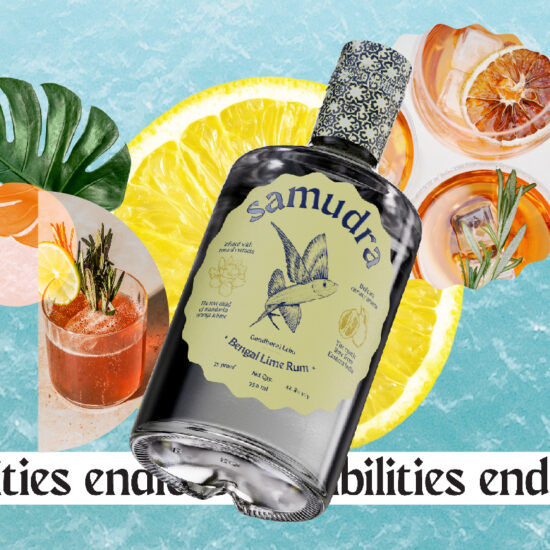GIZ India
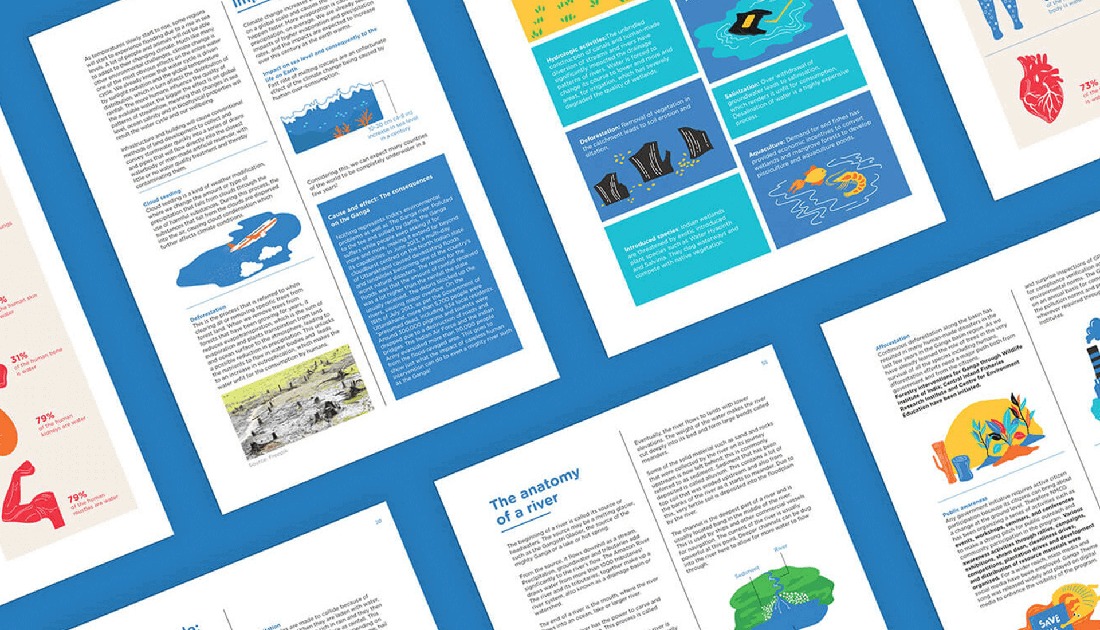
Key Stats
-River Ganga is the largest as well as the longest river in India with a course length of 2,510 km and with a basin size: 1,086,000 km²
-It flows through 5 countries and 8 Indian States with a catchment area of 1.09 million sq. km affecting more than 400 Million Indians living in the Ganga River Basin.
-As of 2019, around 97 towns and cities located on the banks of River Ganga discharge over 3.2 billion litres of untreated sewage into the river daily.
-In the past 5-6 years, lndo-German Cooperation on rejuvenation of river Ganga has taken off using the German experience in applying Integrated River Basin Management approaches for restoring rivers in Europe, such as the Rhine, Danube and Elbe River Basins.
Context
GIZ India and IEWP (India-EU Water Partnership) came up with a project called Support to Ganga Rejuvenation. This project was aimed at children and hoped to encourage a positive behaviour change at a young age, towards water usage, sanitation and hygiene. The premise of the entire project hinged on tools that would promote this change and thus start attitudinal shifts at grassroot levels. This process was to involve both students and teachers, so as to instill a natural sense of the importance of water and water management techniques, which would hopefully snowball into positive steps towards water and the environment in general.
The Brief
As the communication design partner for Support to Ganga Rejuvenation, we delivered a wide range of communication material for their public outreach program along with developing elaborate pedagogical tools.
The brief was clear on how communication and public Outreach form an important cross-cutting theme for both SGR and IEWP. Communication in general seeks to inform the stakeholders with knowledge regarding the project action,The objective of communication within the project is to inform and educate diverse stakeholders and to involve them in the process so as to ensure the long-term sustainability of the project. The programme activities aim to contribute to raising awareness and encouraging behaviour change related to Ganga rejuvenation.
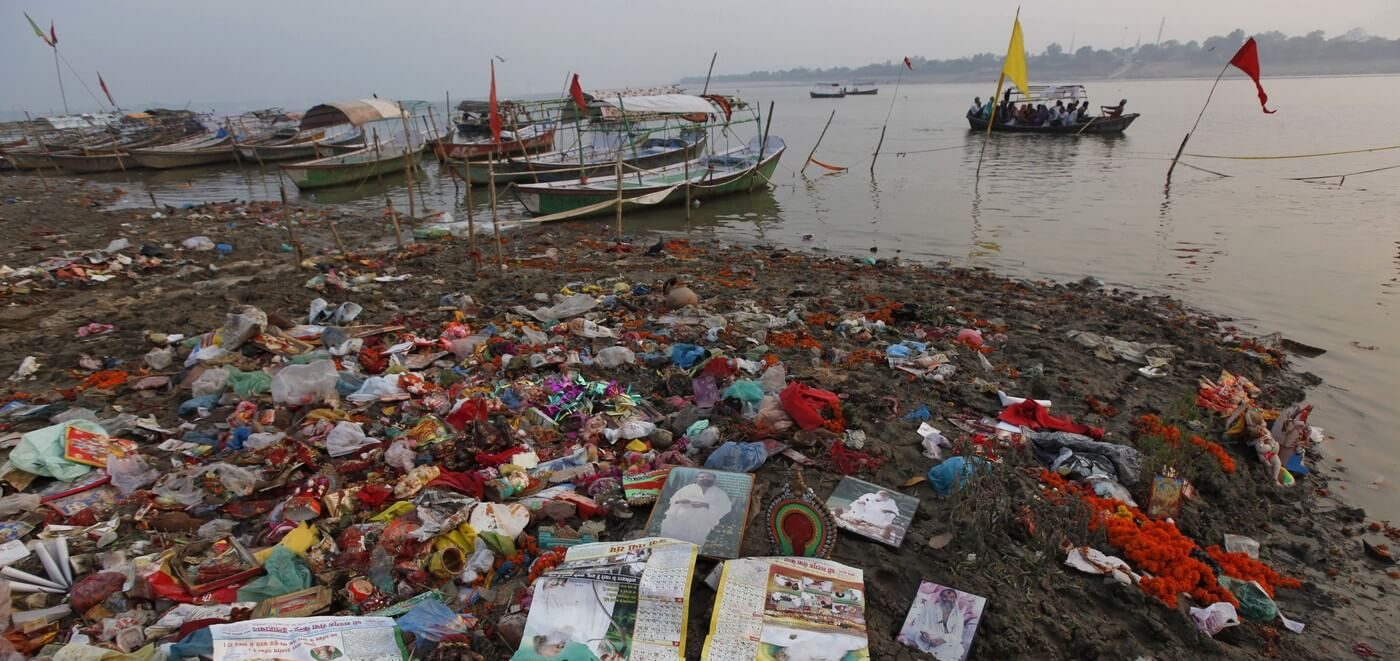
The deliverables include project branding, website design and development, branding and collaterals for multiple events. It also included a very expansive ‘Ganga Box’ and other related print material, pocket booklets, and games.
Ganga Box
An Overview
The Ganga Box was conceived in 2018 inspired from the Danube Box, a comprehensive educational tool for teachers and educators in the ten Danube countries. The Danube box aims at bringing people closer to the river that touches so many countries and lives1. Similarly, keeping in mind the urgency of the matter, the Ganga box is designed to make river Ganga, and its protection, a part of the school curriculum for places in and around the Ganga river-basin. More than it being a manual for school kids, it is a tool for teachers to educate students about the river and the various aspects of its management.
We came on board in June 2019. Immediately, we took over the strategy and design of the Ganga box. It essentially comprises 8 chapters in two languages (English and Hindi) – each focusing on a different aspect of the river. The chapters are packed full with visually supported information, fun activities and even stories for kids to indulge in. Each chapter has multiple activity sheets. Along with the chapters, the Ganga Box comprises educational games like Snakes and Ladders (modified), Picturecca, Who am I?, and many more to create an immersive learning experience for kids.
A good design process is iterative and ever evolving. With insights from multiple rounds of internal and external feedback, testing at teachers’ training programmes, and by virtue of a systematic creative process, the Ganga Box has gone through three major iterations.
Edition 1: September 2019
Edition 2: December 2019
Edition 3: August 2020
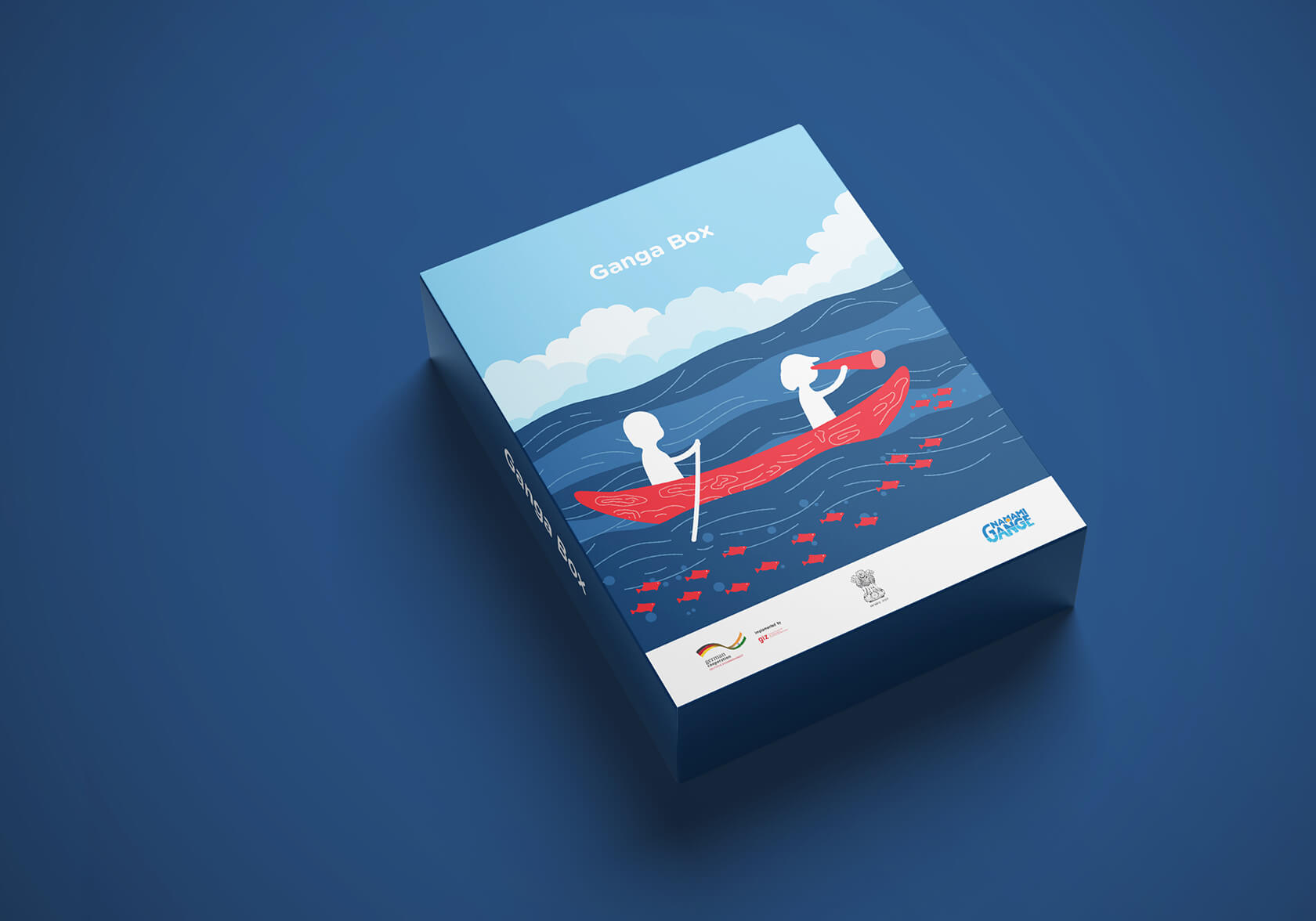
Research and Ideation
Before we began to design the first edition of the Ganga Box, we underwent a primary and secondary research phase. To begin with, we collected literature on the subject matter including textbooks, children’s books, geological accounts and even folklore. As part of our primary research, we visited a government school in Delhi with a set of questions to shape our understanding of our key demographic – school-going kids. We carried picture books with us for the kids and a few games to play with them. We observed that they were intrigued by hand drawn, organic-looking illustrations that are not very realistic, that are colourful and engaging.
This helped us come up with an illustration style for the Ganga Box. The keywords we finalised were – Organic lines and shapes, busy, and colourful. In order to keep the look and feel colourful yet orderly, we chose blue as the key, constant colour with every chapter having a couple more colours to brighten it up. This way, we schematized the chapters while maintaining a large colour palette.

Later, the primary blue was also used in the official SGR branding.
Edition 1
For the first edition of Ganga Box, our core approach was fairly simple. We set out to design study material that would entice kids to take it up and consume voluntarily. The full-page illustrations and exciting colours were a product of this approach.
Design Specifications
– In our experience, the international A4 is an intimidating size for a kid’s book. Our goal was to make it more accessible and friendly. We were well aware of the fact that the addition of the Ganga Box to the school curriculum meant additional work for both students and teachers. In an attempt to compensate for the same, we chose to make it look fun and exciting instead of it being plainly informative and educational.
– We came up with a relatively smaller custom size, colour palette and illustration style.
– In this phase, each chapter was designed as a separate book.

After the launch of the first edition of Ganga Box, it was time for us to put our thinking hats on once again. Along with the feedback we received from GIZ and other stakeholders, we had several internal review sessions. Here’s what we found out:
Feedback and key insights
1. The chapters cannot be bound in a book but instead need to be loose sheets of paper that can be taken out and inserted in, added to and removed from the bundle at any point of time.
2. Inside the box, we will need to have a folder designed to carry the loose pages.
3. The size of the pages is inconvenient for teachers to photocopy and distribute among kids.
4. It is not a story book, but a potential piece of school curriculum and needs to look and feel accordingly.
5. The designed chapter pages are not directly meant for kids to handle, but for teachers to read out from.
6. The illustrations, thus, look too heavy and distracting.
7. We also realized the need to disintegrate bigger illustrations into many spot illustrations pertaining to smaller chunks of text.
8. Number of activities needs to be increased for regular breaks in between textually dense segments.
9. Certain important bits of information are missing. For ex: Emphasis on Biodiversity in the chapter on the Ganga Basin Ecosystem.
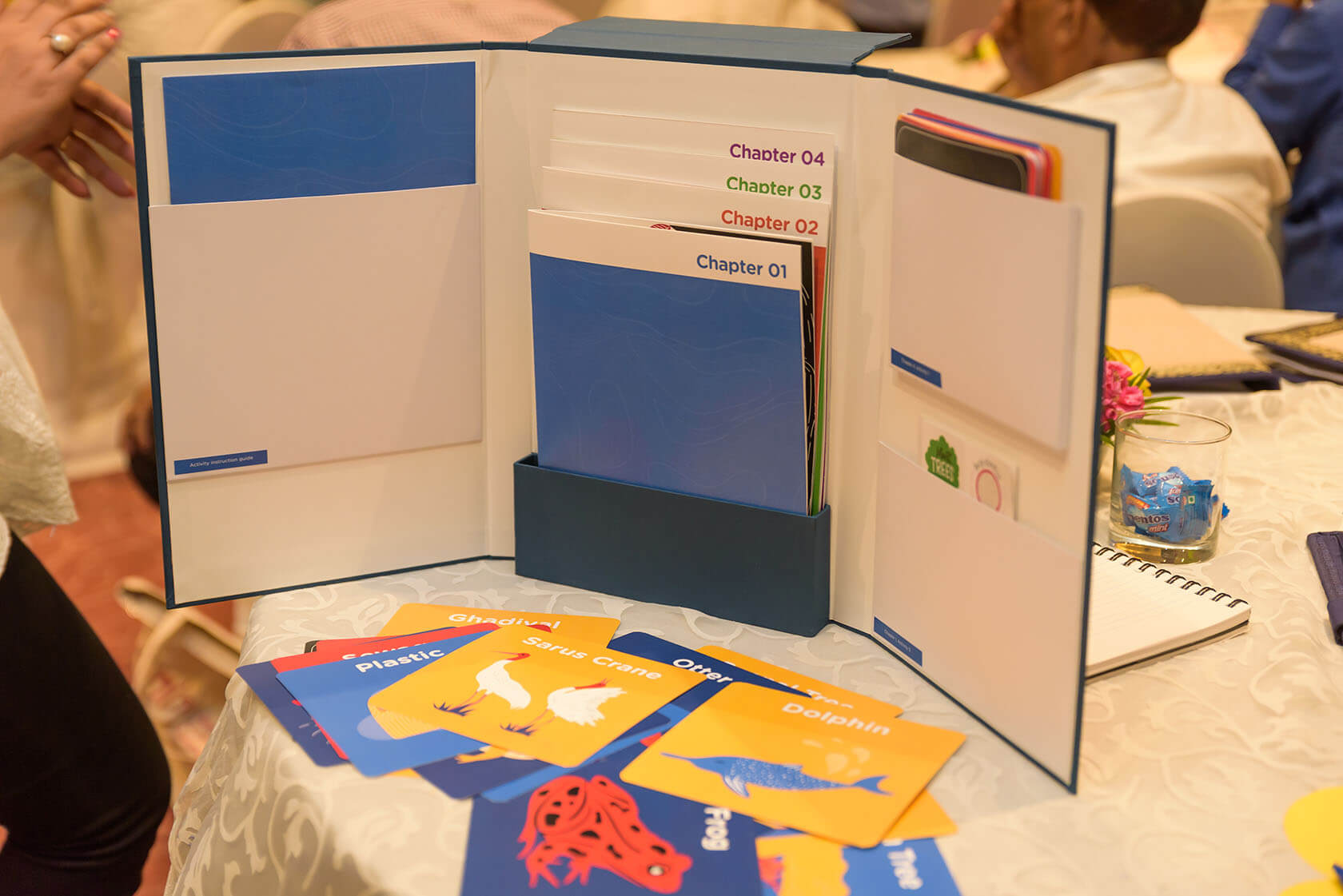
Edition 2
In order to tend to each of the aforementioned concerns, edition 2 of the Ganga Box was re-designed afresh and all chapters were rewritten. This helped us take care of any avoidable design inconsistencies to start with. As the chapters were being written, they were simultaneously being translated to Hindi.
In terms of design, the first step was to change the size of the brochure to a standard A4. Along with that, we worked on creating a new set of illustrations and activities to help the body text breathe freely.
In this edition, we also aimed at adding relevant photographs wherever required. Each page was meticulously redesigned to have a more balanced text to visual ratio.
The pages were placed together in a custom designed Ganga Box folder which was then places into a custom designed Box for the folder for testing at the second Teachers’ Training event.
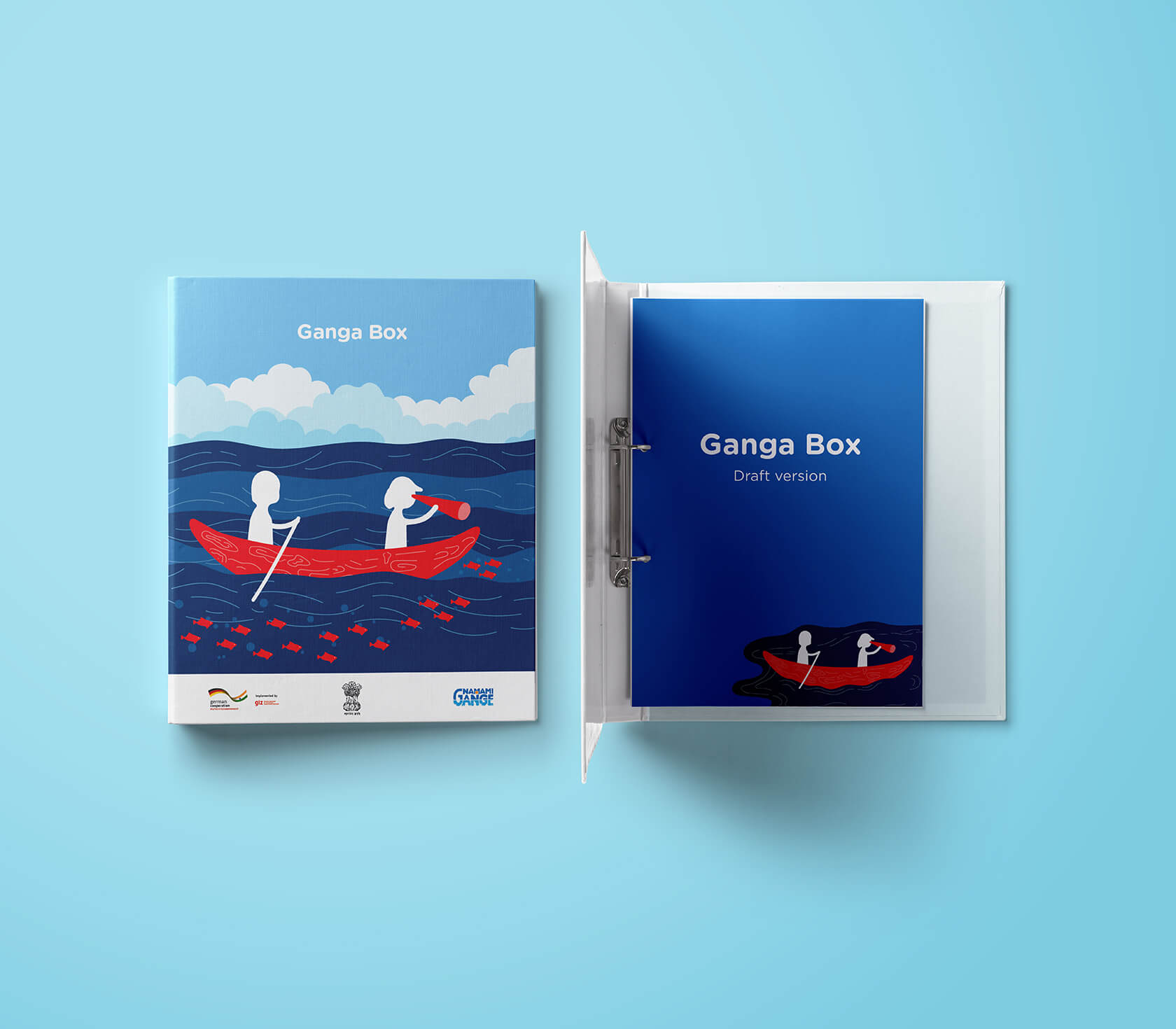
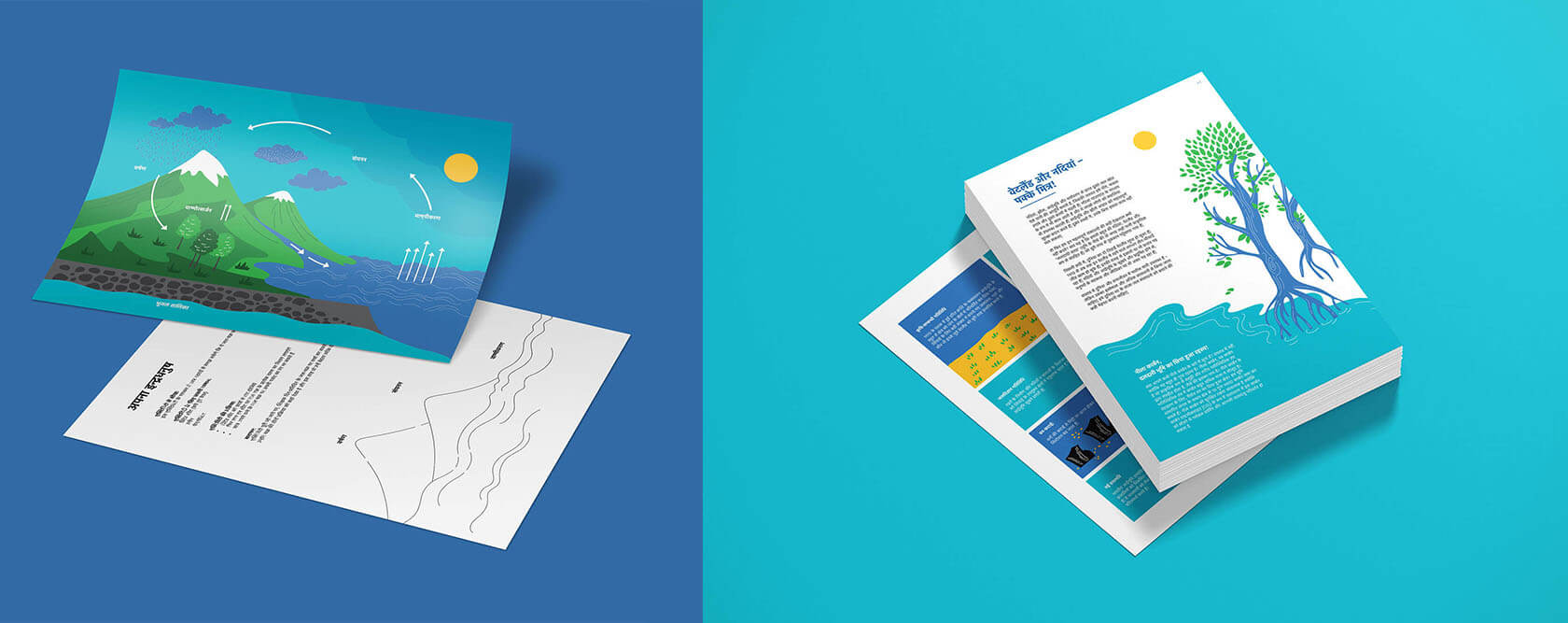
Feedback and key insights
The second edition of the Ganga Box was shared during the second teachers’ training programme in December 2019. Along with the feedback from the organizers (and moderators) of the eventSchoolnet, and the teachers invited for the event, we hired two experts to help us with the third and final edition of Ganga Box.
Pedagogy expert – Mrs Sharmila
Subject matter expert – Dr Nagdali
Feedback by the experts (more to be received from school net and teachers who were a part of Teachers’ Training – 2):
1. It is unclear as to what age group is the target for the Ganga Box. Some parts need a higher level of understanding, while some are very preliminary in nature.
2. It would be better to segregate the activities into two divisions – Junior level and Senior level.
3. The data needs to be cross checked.
4. Provide alternatives to non-sustainable material and methods.
5. We need more stories to engage the kids. Each chapter could start with a Ganga Tale. Short stories inspired from real events to be added where relevant to inspire children to take action.
6. There needs to be a better flow between topics in some places.
7. Some topics need to be added or elaborated on to build a coherent narrative.
8. Chapter 7 will be redesigned to a much simpler timeline format with a broad introduction of NMCG, rest of the initiatives to be interspersed in the relevant chapter to make it easier to understand and correlate.
9. Content on Urban/rural/land planning to be added, several other methods of sewage treatment and disposal to be added besides STP.
10. In the end, additional information to be provided for kids to be able to act as a whistle blower against excessive pollution instances and change in environmental patterns.
Edition 3
(In Progress)
Although the second edition of the Ganga Box was met with success at the training events, there were a few gaps to be filled. We noticed that certain topics needed more elaboration, we wanted to add more activities, and have a more orderly structure for the content. To achieve this, we began working on the third edition of the Ganga Box with both the experts on our side.
Design
The size of the page will remain the same as that in edition 2. However, the layout might see revisions as the content structure has changed entirely.
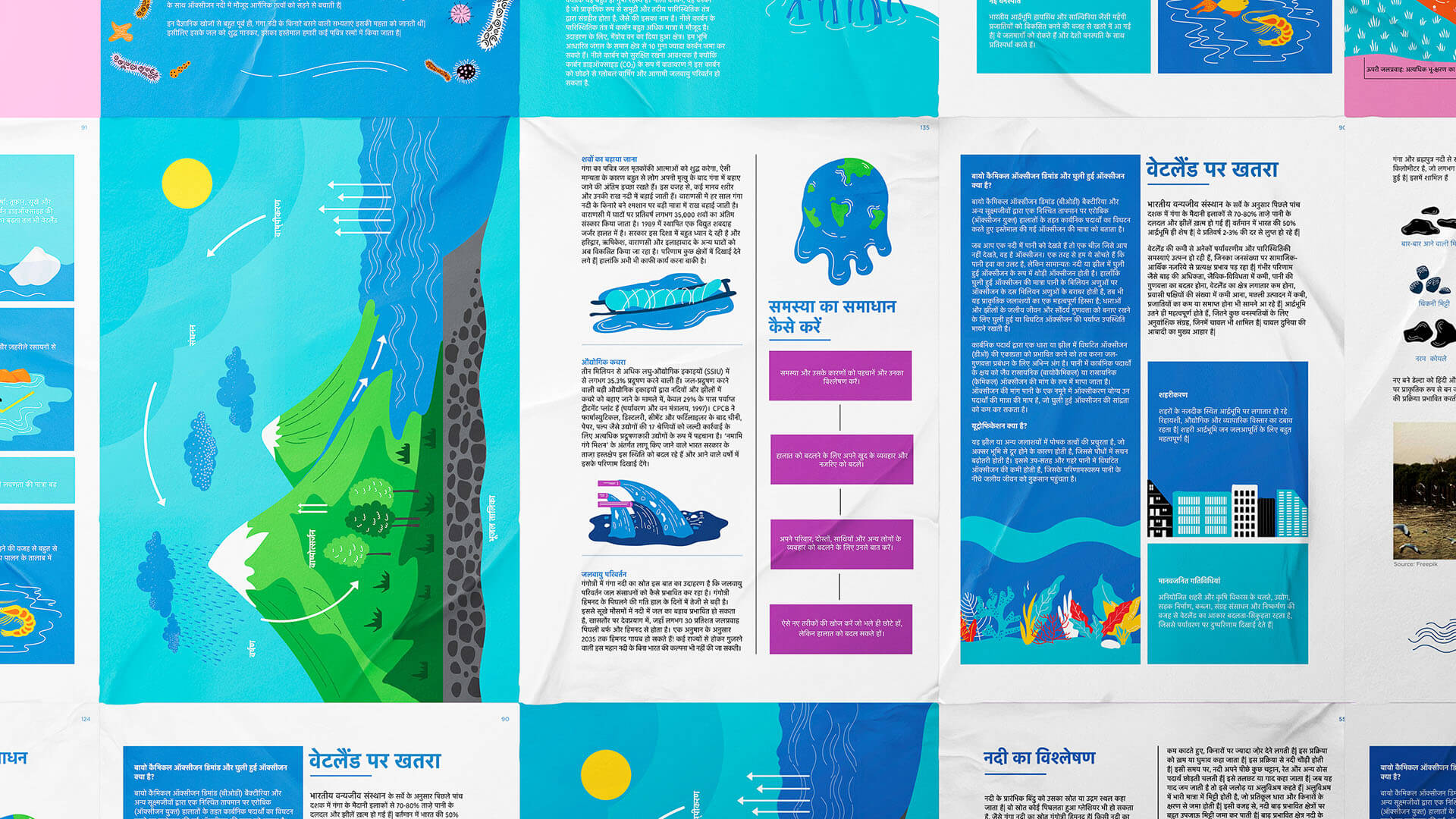

The Ganga Box also includes activities and games for kids to engage with the subject matter. Here are some of them:
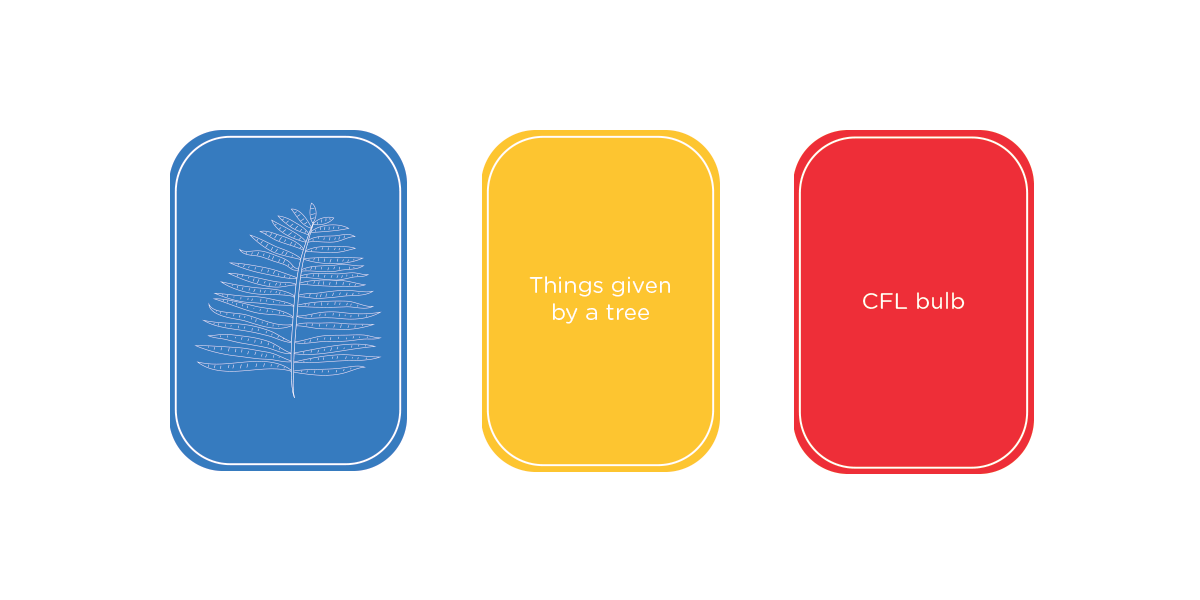
Know your waste
Know your Waste is an interactive simulation for children that teaches them to segregate daily waste. The interface visualizes two bins namely ‘Dry Waste’ and Wet Waste’. Various waste items drop from the top and need to be sorted into respective bins. The game ends with a score tallying the correct action of segregating waste into the appropriate bin. The game is a fun way to remind children which items are biodegradable and which are not and thereby inculcate a good habit. The visual language uses bright colors and realistic shapes to capture their attention. The game was also physically manifested at events with the help of cut-outs of the waste items and color-coded garbage bins the way they occur in real life.
Picctureca
The game comes with nine tiles, two dice (number dice and colour dice), timekeeper and question cards. There are three categories of question cards – blue cards which have pictures, red cards which have names of specific objects and yellow cards which have questions.
To start the game, players will arrange all the tiles in a 3×3 grid in any order. Since the order and orientation of the tiles change each time you arrange them, it is very hard to remember the position of each picture for any player.
Each player rolls both the dice, the colour dice tell them which colour card to pick and the number dice tells them how many pictures to find. The player needs to find the pictures within the time limit in order to win the card.
The player who wins the most cards or is the first to collect six cards wins this game.
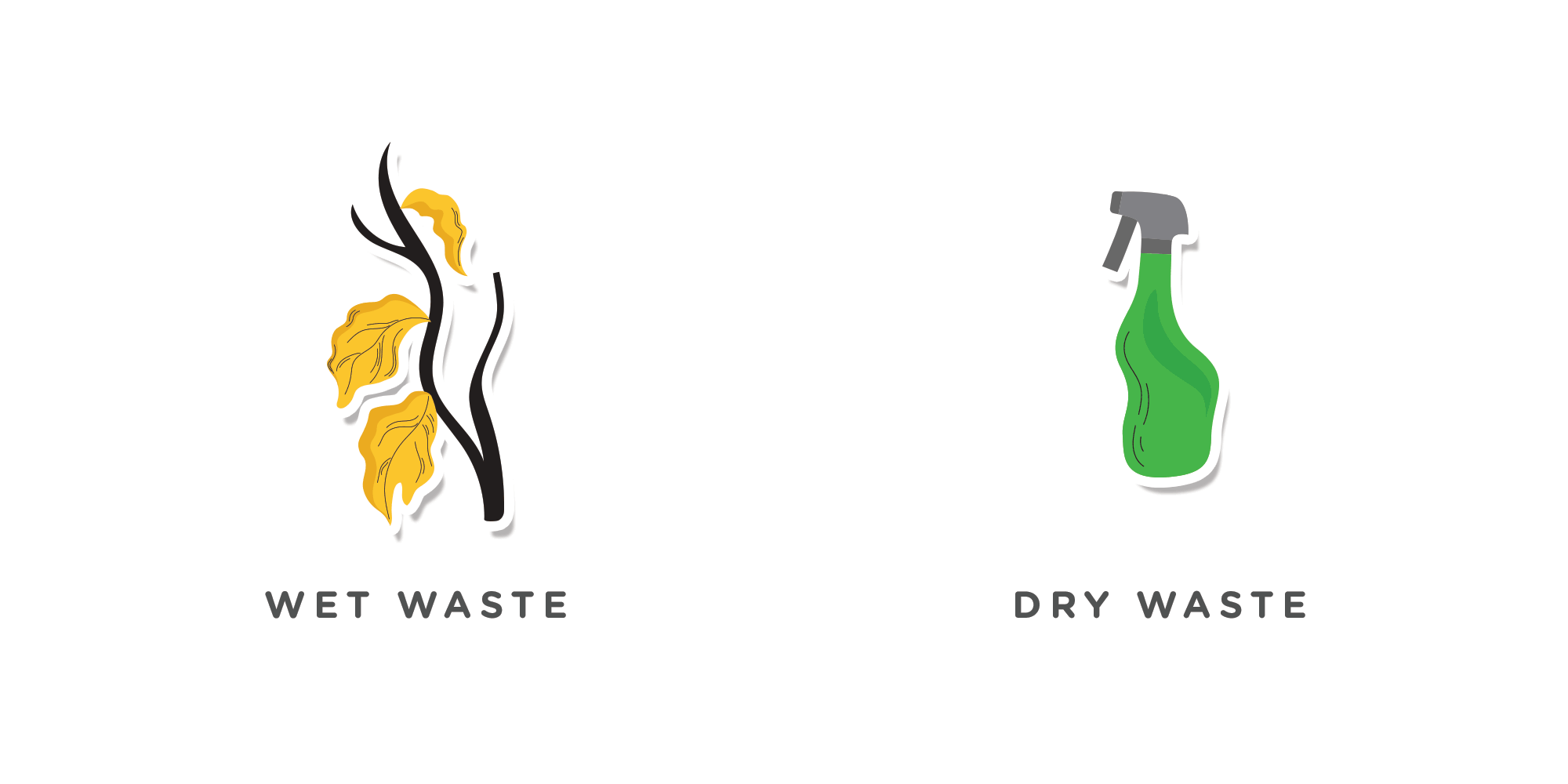

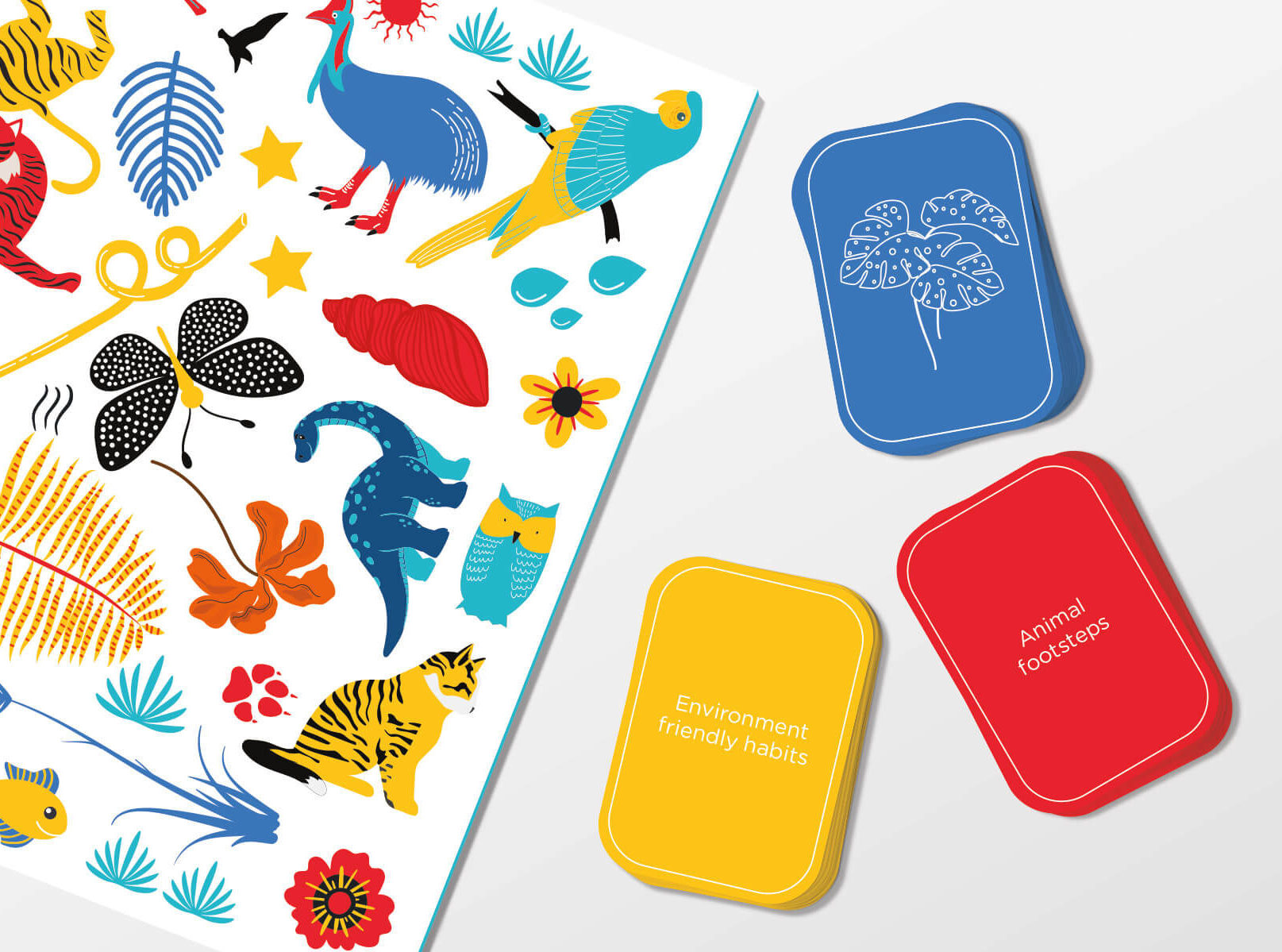
Choose your Snakes and Ladders
We designed an environment-themed Snakes and Ladders for the Ganga Box. Just like the original Snakes and Ladders, this is a board game but with a twist. Kids design their own game as the play by placing cut-outs of different snakes and ladders at appropriate places on the board. They are given good or bad situations based on which they make decisions regarding whether that particular spot on the board deserves to have a snake or a ladder. With the usual ‘snakes and ladders rules’, kids race to move forward on the board to reach the end of the game.
The snakes and ladders are cut-outs which can be placed on the board as per the instructions. Here’s the design for the board.
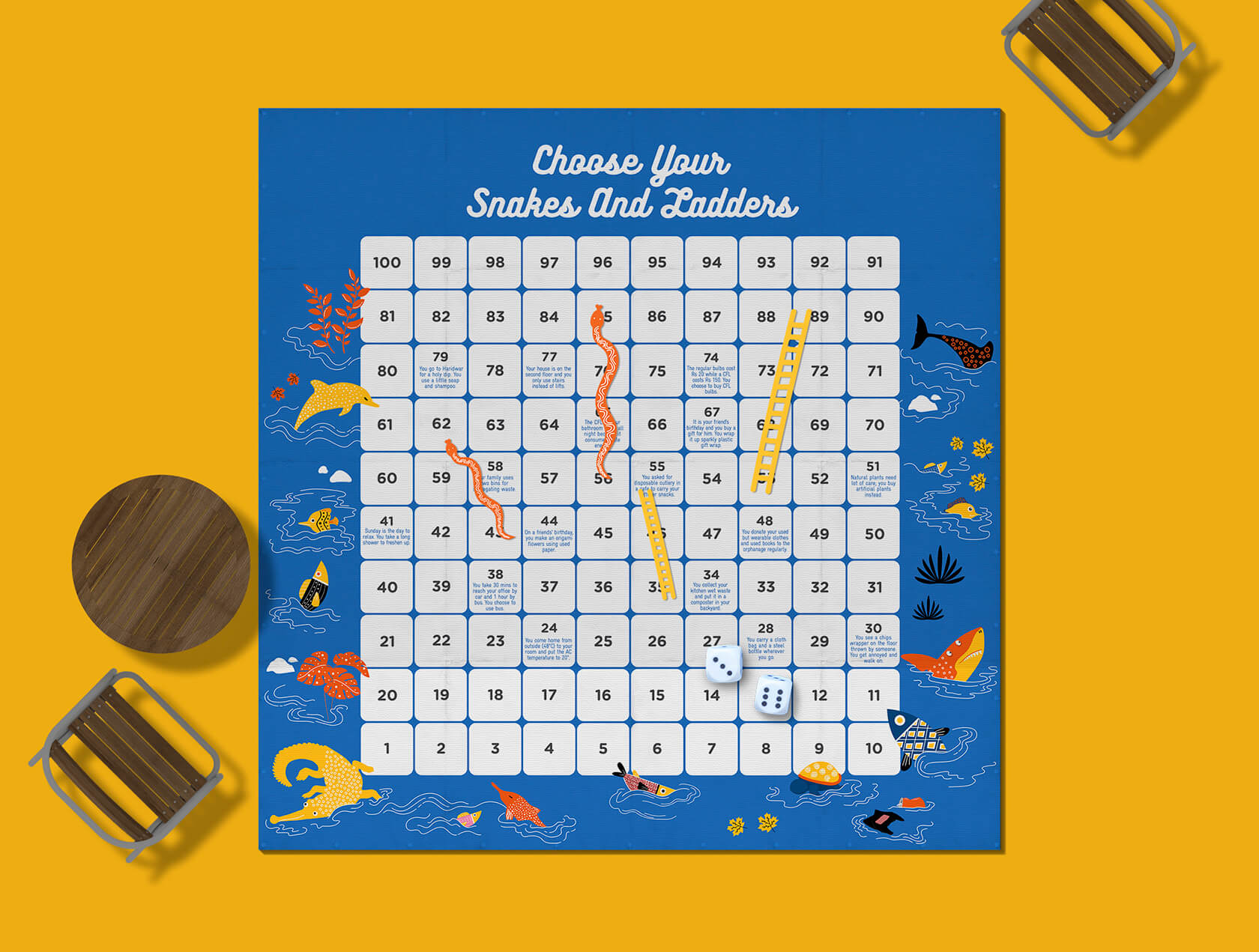
Who am I?
‘Who am I’ is a card game that is designed for kids to be played in classrooms as well as at events. The stash includes two kinds of cards – hint cards and name cards. One kid holds the name card to his forehead revealing the name of the animal, city, river, etc related to Ganga. He has to guess who/what that is based on hints given by the other players using the hint cards.
This game pushes kids to know more about River Ganga and its ecosystem and encourages participation and teamwork.
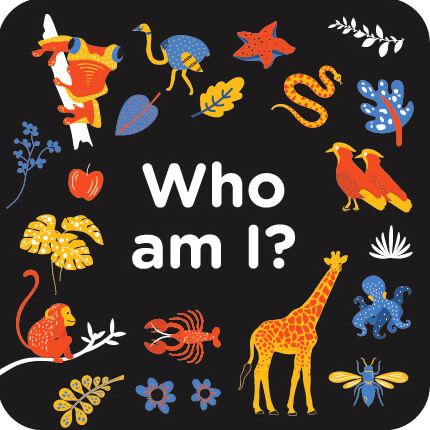
Quiz Cards
One of the games designed along with the Ganga box is the Ganga ‘Quiz Time’. There are two levels of difficulty, junior and senior in the quiz questions. We illustrated the front side of the cards using familiar river Ganga elements and the back side has the questions and answer options. Each card has one question that the teacher can read out. If the kids don’t know the answer, the teacher can also read out 4 options of answers for the kids to choose from. The right answer is highlighted for the teacher.
The cards are 3.5” x 2” in size and have rounded edges for easy handling. The cards were designed in both Hindi and English.
Here’s what they look like.

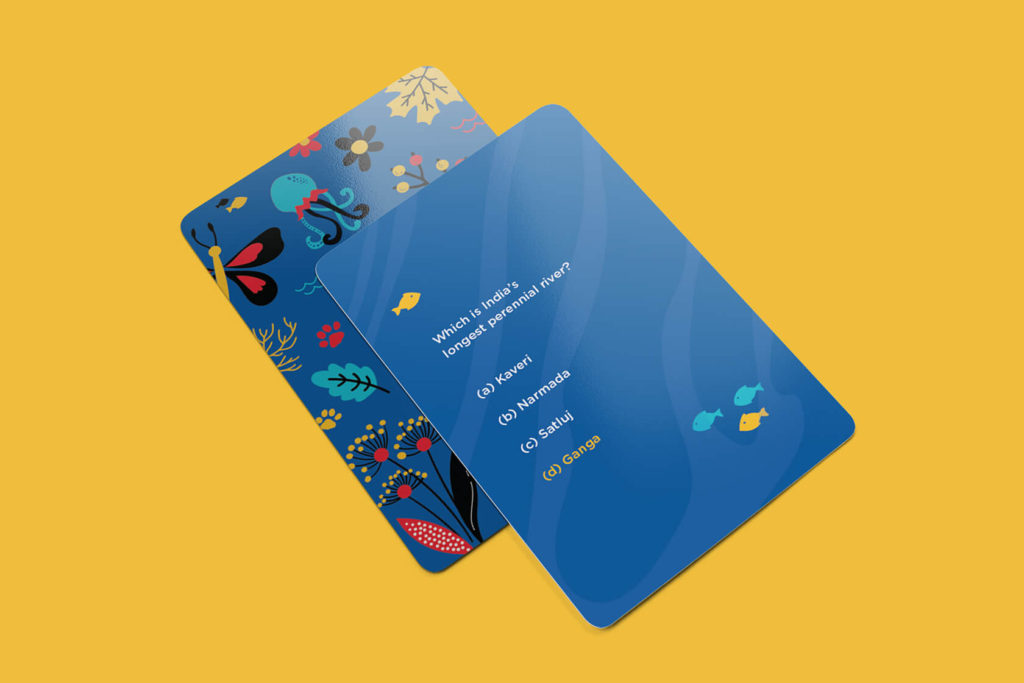
There is no planet B
There is no Planet B, a pocket booklet, was designed for an event organized on the occasion of World Environment Day, 5th of June, 2019. It speaks to children on how they can take small steps in their everyday life to ensure a longer life for our home planet. The artworks on each page were designed using limited hues and simple shapes to make the message look prominent. Some of these illustrations were also made into looping animations. The size of the book is A7 and it was printed on recycled paper.
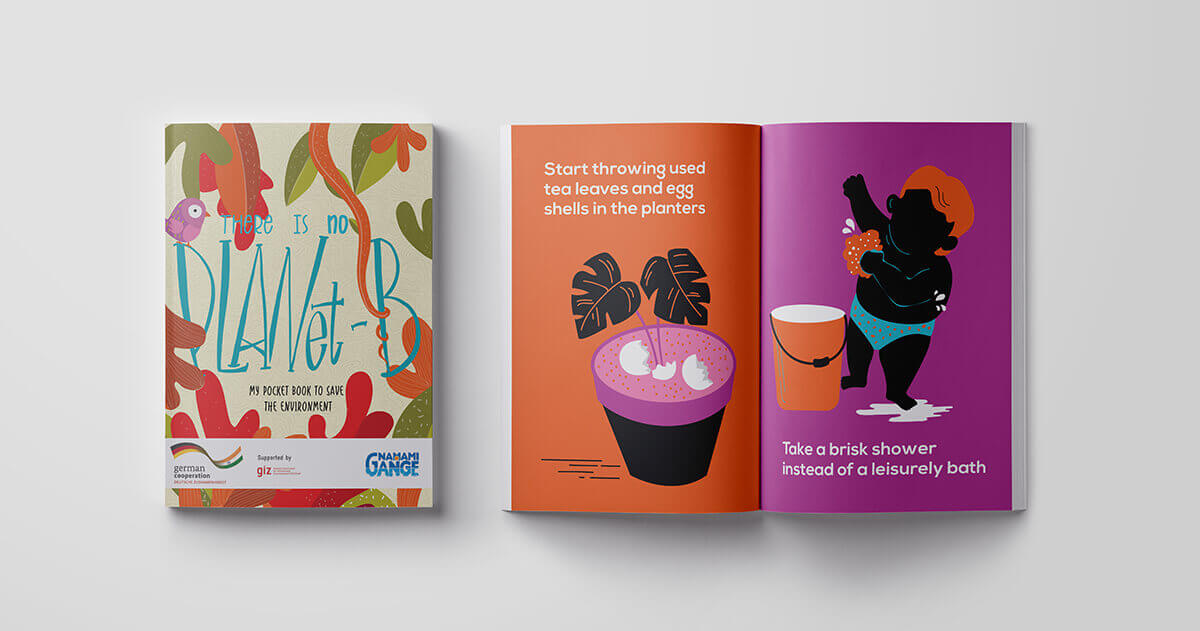
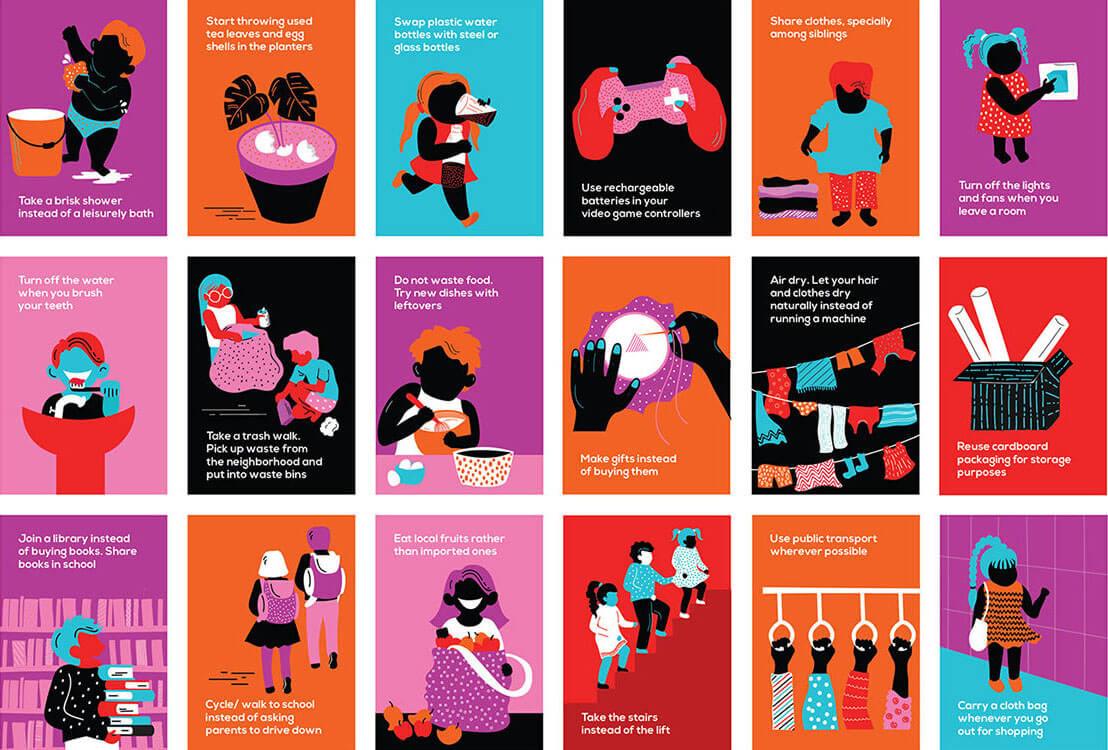
Pilgrim’s Guide
‘Ek ek kar kadam badhaye, Apni Ganga Swachh Banaye’ – Let’s take steps towards making our Ganga clean, says the title of another pocket sized booklet that we designed. It aims at guiding tourists, especially pilgrims in making environmentally responsible choices while travelling.
This booklet targets behaviours that negatively impact the environment like throwing trash in the river, as well as those that affect the flora and fauna around water bodies in places of pilgrimage. It was designed in Hindi to better suit the average Indian pilgrim.
The illustrations were purely supportive and thus, simple, while the language used was lucid to communicate clearly in a small space.
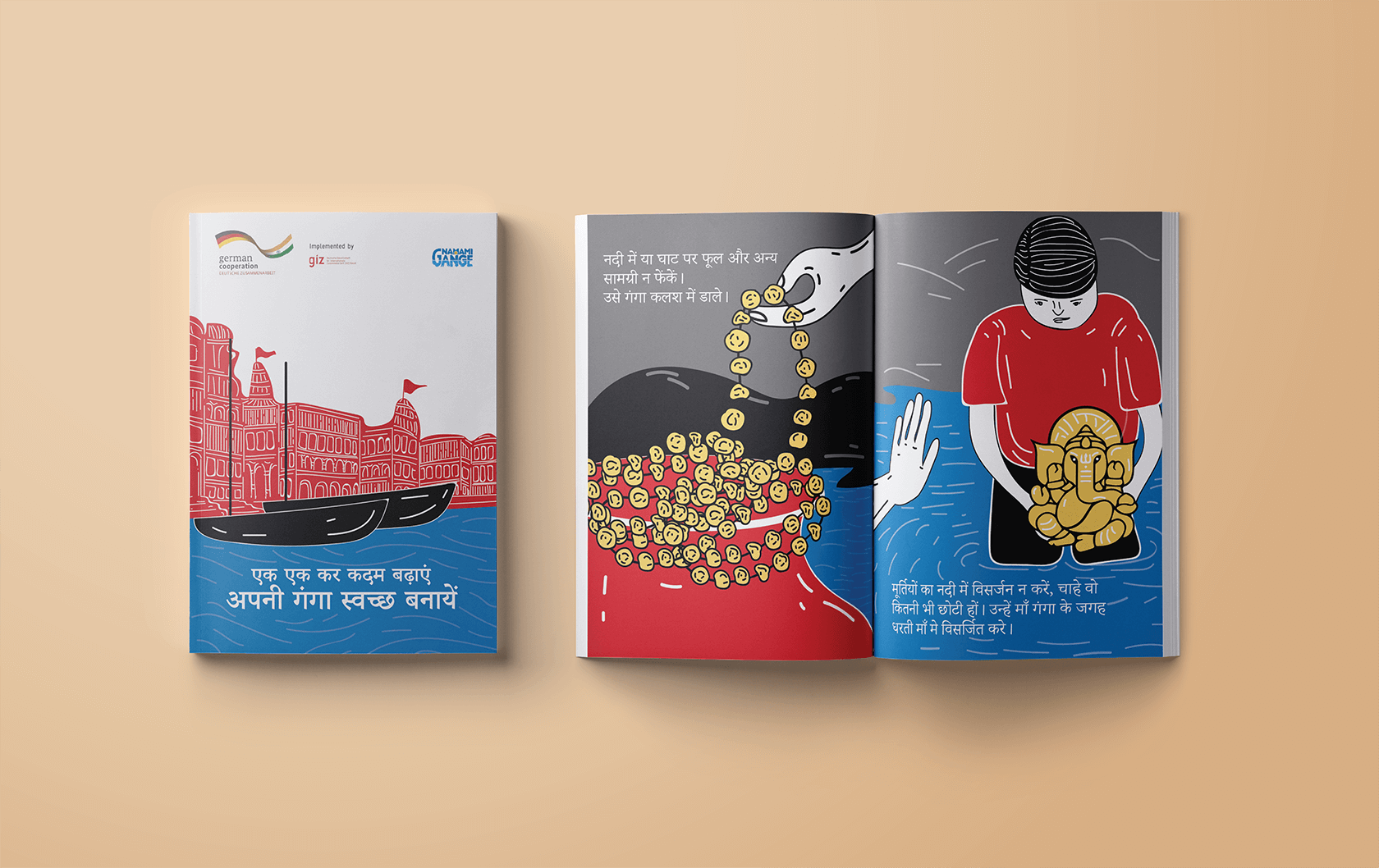
Apart from the public outreach programme, project SGR also focuses on providing relevant training to its stakeholders. Following is the work that we did for a few events hosted under the project.
Events
Competence Training Programme
The Competence Training Programme under the Support to Ganga Rejuvenation Project is a 09- day module spread over a period of 6 months. It aims at enhancing the management capacity of professionals and executives of NMCG, SMCGs, executing agencies such as Jal Sansthan, Pay Jal Nigam, Agriculture departments, Pollution control boards etc.
The concept of concentric circles indicating continuity, process, the relationship between different components and spreading of knowledge was was visualised as ripples for the final branding of the event.
In the context of the competence training programmes, the circle is being used as a metaphor. Circles are universal symbols representing totality, wholeness, the self, infinite, timelessness. As the sun, it is masculine power; as the soul and as encircling waters, it is the feminine maternal principle. The design explains how drops of water (03 modules) when meet the centre (our life) have the potential to create ripple effect that indicate: continuity, process, the relationship, the idea of forward movement. It further implies the idea of movement and symbolises the cycle of time.
We designed the participants’ handbook for this module. The handbook went through 3 major iterations. Each module was dedicated a few pages of notes and an introductory section. We included photographs related to competence building and the key colour was SGR blue along with 6 other blues, one from each ripple as seen on the cover. Here are a couple of spreads from the final version of the handbook.
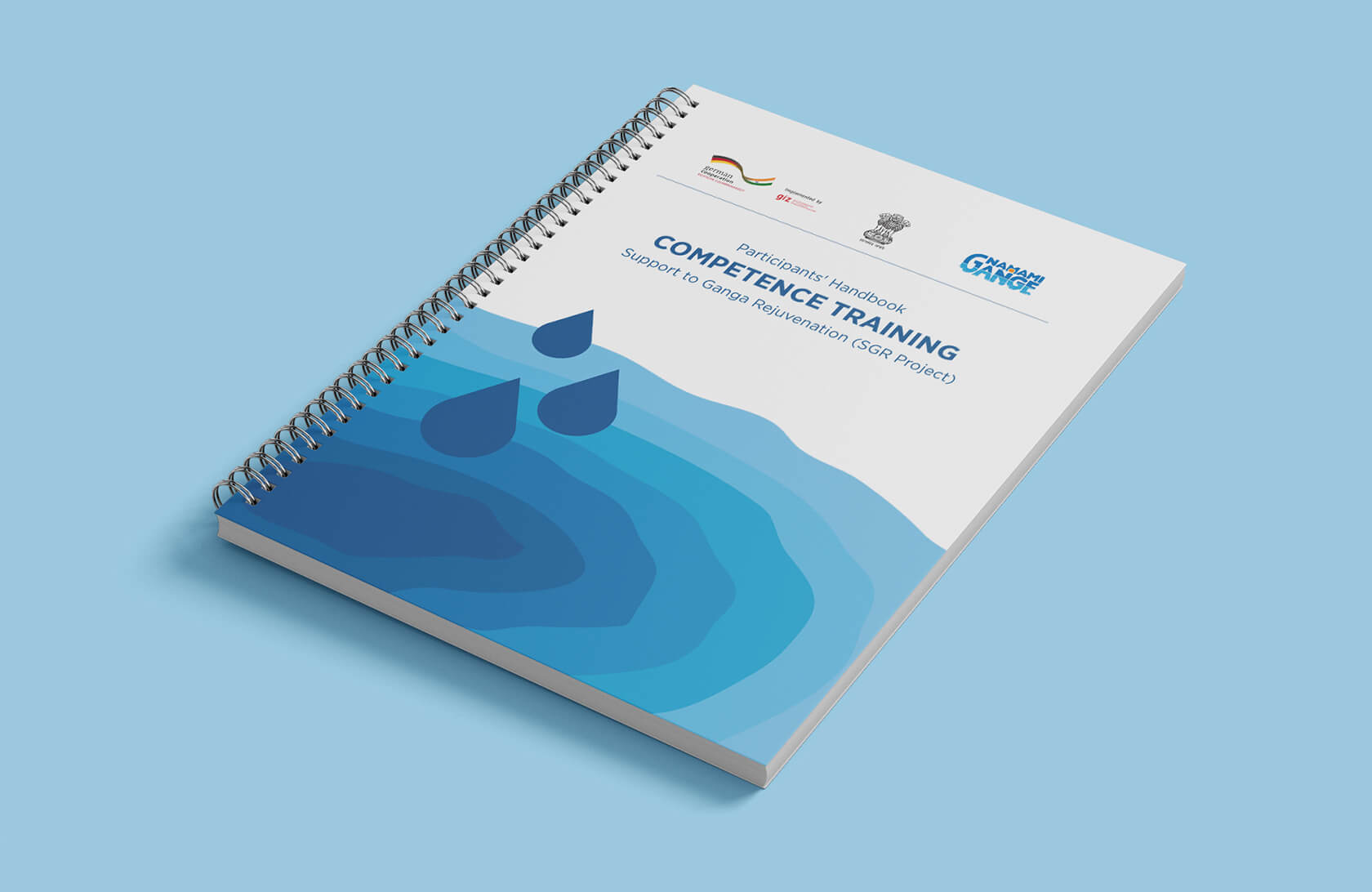
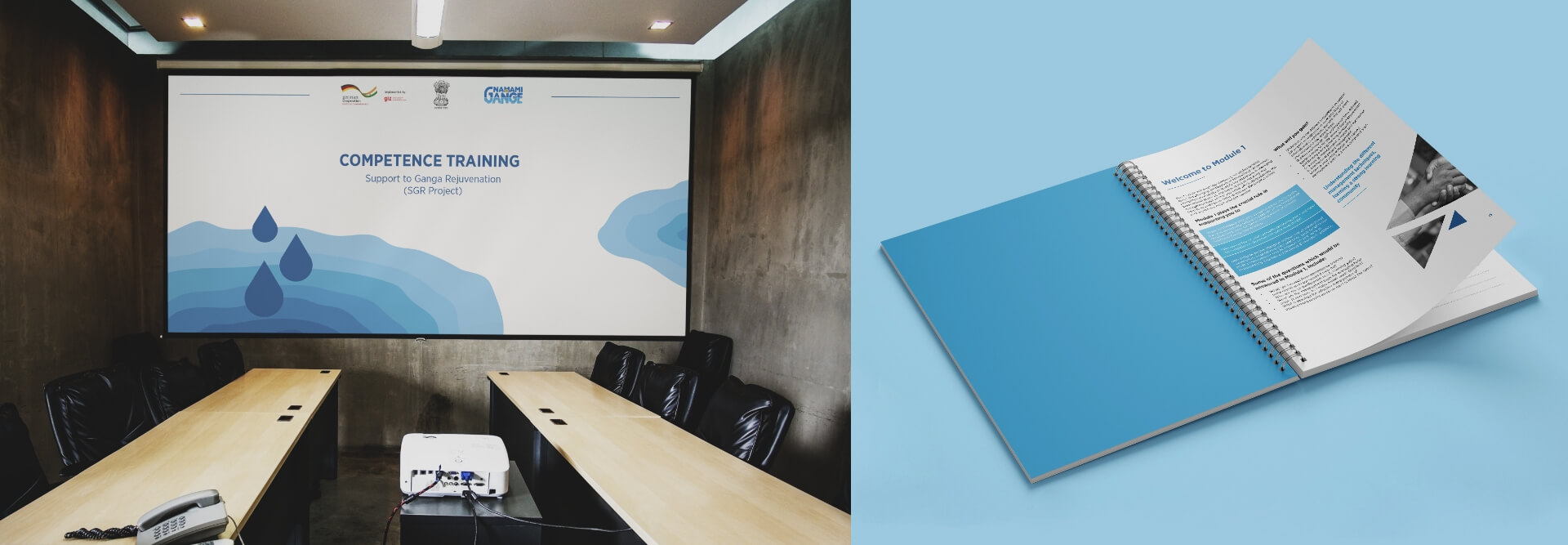
Teachers’ Training Programme
The first Teachers’ Training was held in 2019 in New Delhi. Principals of schools from Uttar Pradesh and Uttarakhand were invited for this event where they were briefed about GIZ, its work and why Indo-German collaboration is proving to be significant in the area of Ganga Rejuvenation. They were informed in depth about what the Ganga Box is and associated timelines.
We designed the notebook cover and banner for this event.
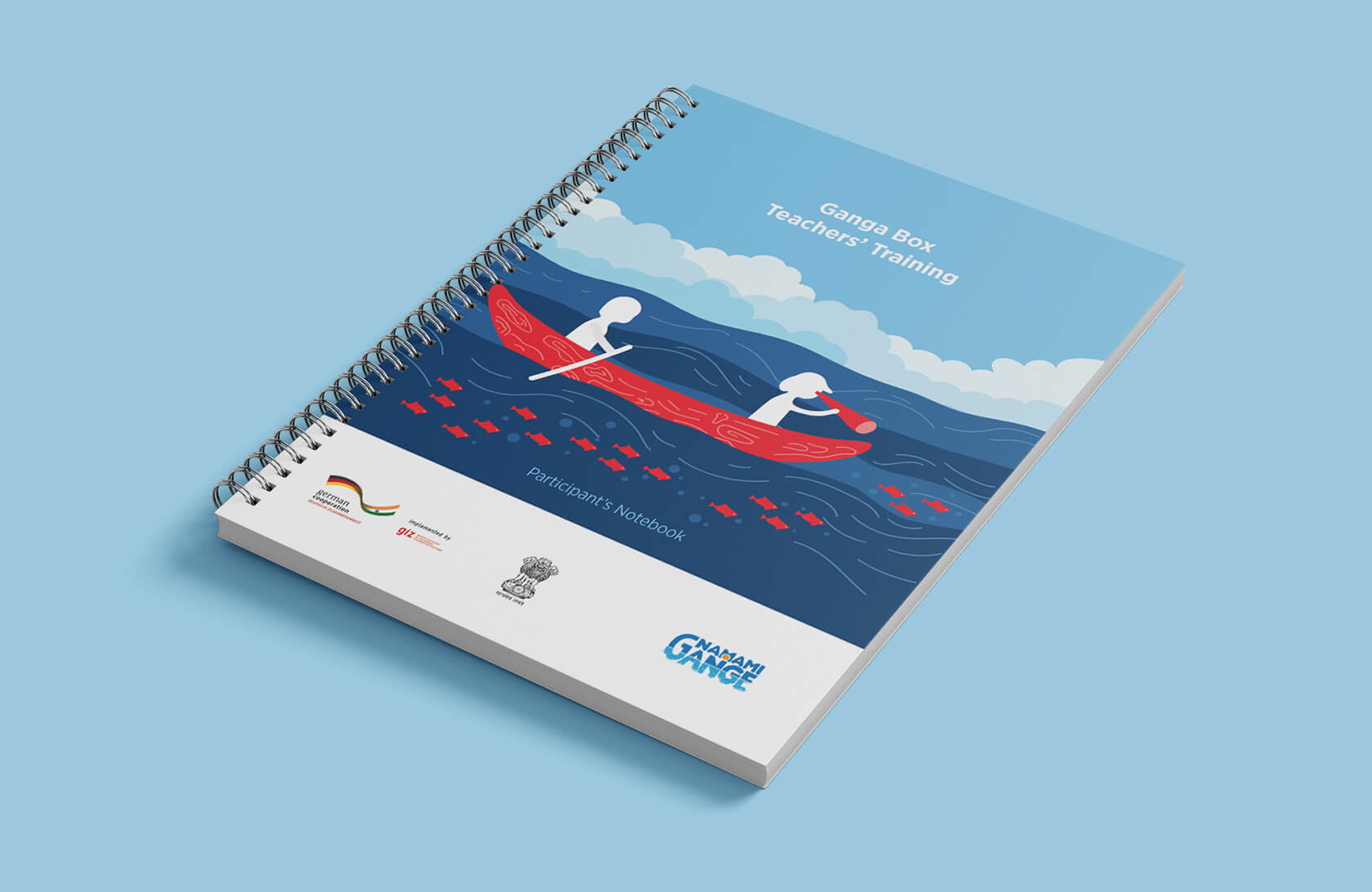
The first four chapters of the Ganga Box were ready by then and prints of the same were distributed amongst the school principals. They had a chance to give it a read, and give comments. They also interacted with games like Snakes and Ladders (3ft x 3ft), Who am I? cards and some stickers designed for kids.
Discussions were held on the challenges in including the Ganga Box in the CBSE curriculum. The potential challenges that came up were mostly financial in nature. It was a common opinion among the attendees that the teachers would want some incentive to put in extra hours and efforts to conduct Ganga Box sessions with kids. It was also discussed if the Ganga Box should be called something else. The name, however, was not changed.
E-Flows
E- flows or Environmental Flows Assessment and Implementation for India was an International workshop conducted in October 2019. For the branding of that event, we came up with various illustrative options to begin with. This was done in order to have a consistent style as used in the Ganga Box. We designed many options for event branding. The feedback we recieved was that they would like a more mature, minimal, clean looking design. The following Icon based approach was then developed. We further went on and designed various collaterals for this event.
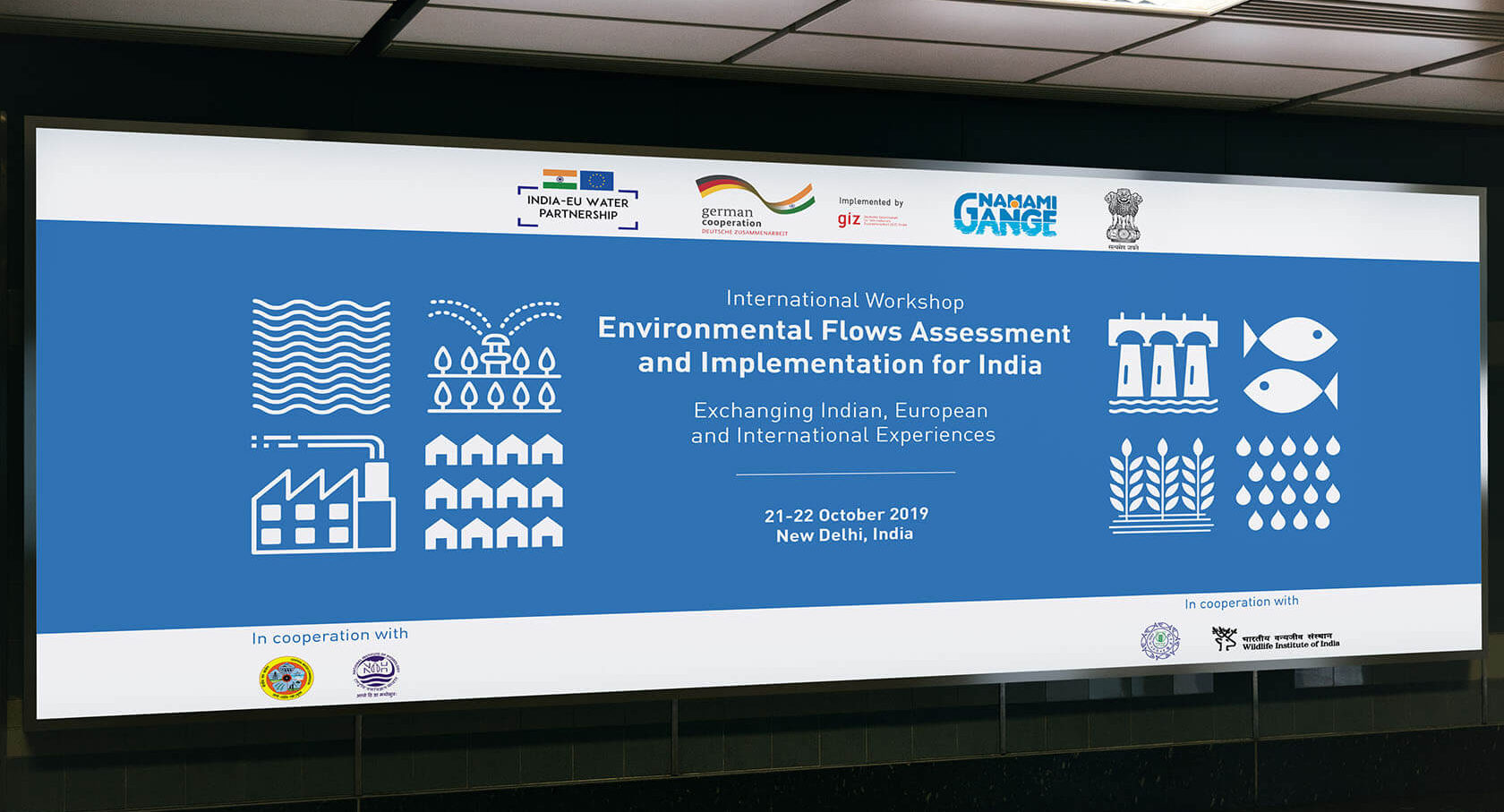
While working on the design collaterals for these events, we realised a need for a strong identity for the project which is flexible and yet creates a lasting impression. We had a chance to develop the same during the RBM (River Basin Management) event.
River Basin Management – Training Series
Project SGR (Support to Ganga Rejuvenation), as the name suggests, is about river Ganga and water management in general. To rebrand the project, we started with the single most fundamental element – a water droplet. The idea is to communicate that every drop matters – every small action contributes to the larger picture deciding the fate of the vast Ganga ecosystem.
For each of the seven themes under the programme, the droplet will carry corresponding narratives. Below is the design for River Basin Management (RBM). It shows the journey of a river from the source, passing by forestlands and villages, its tributaries and finally to its mouth.
Under the droplet, all seven branches of the programme are represented through custom-designed icons. The icon that corresponds to the event is highlighted in the creative.
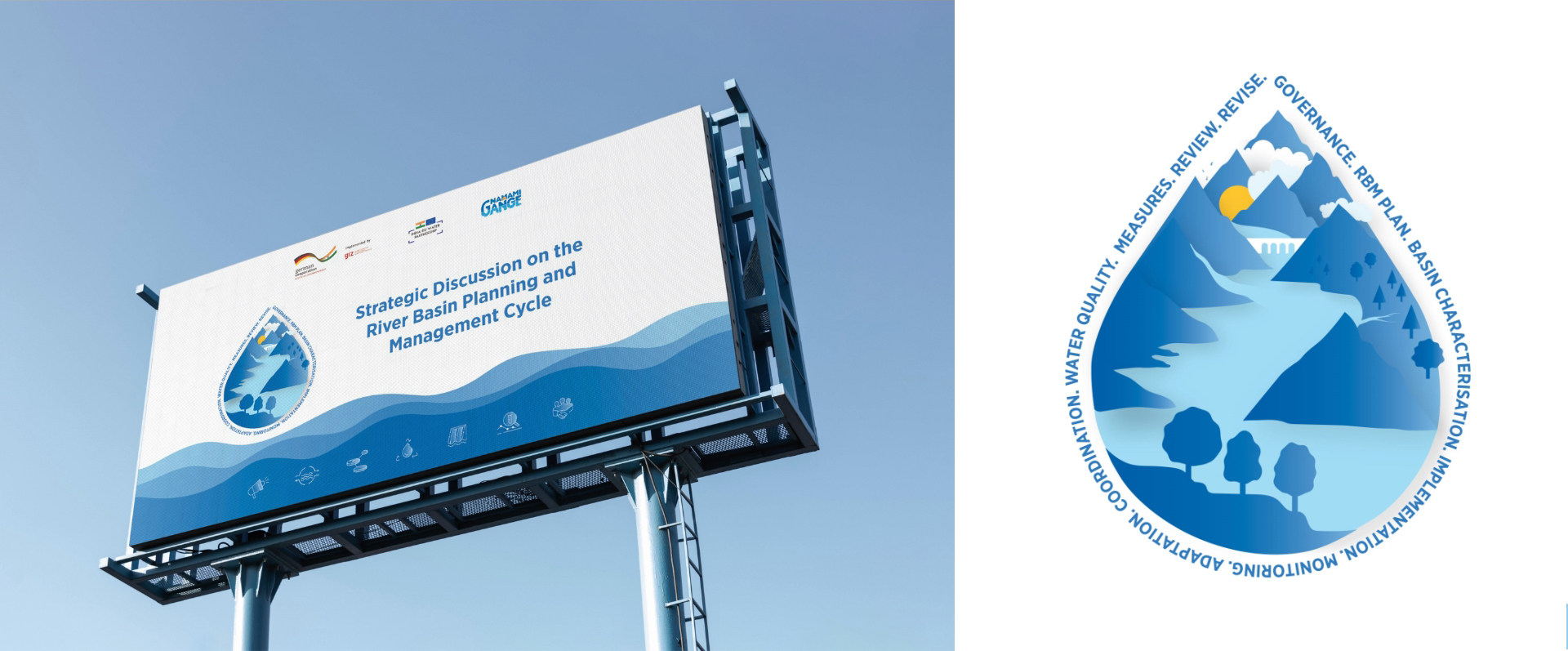
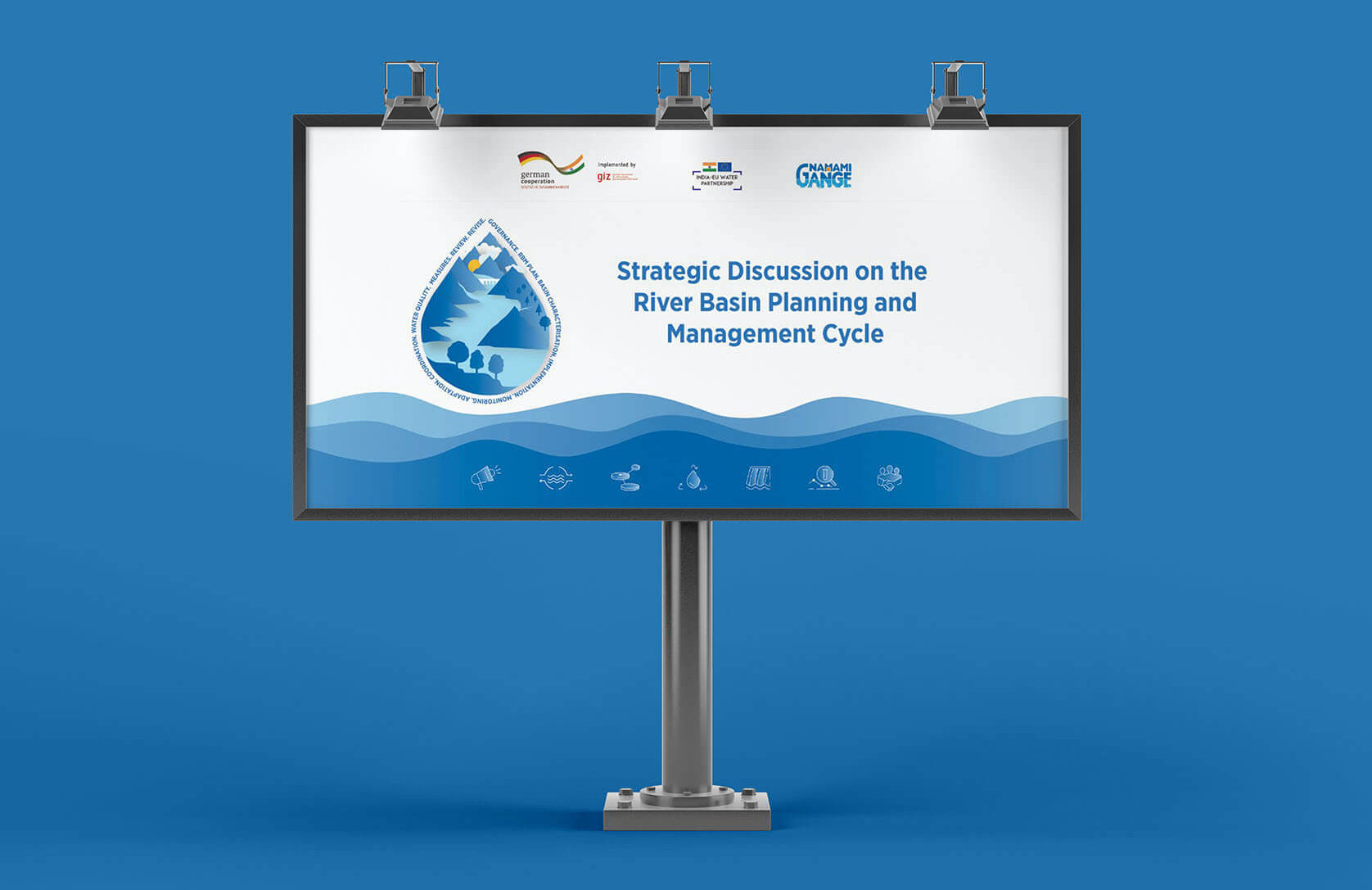
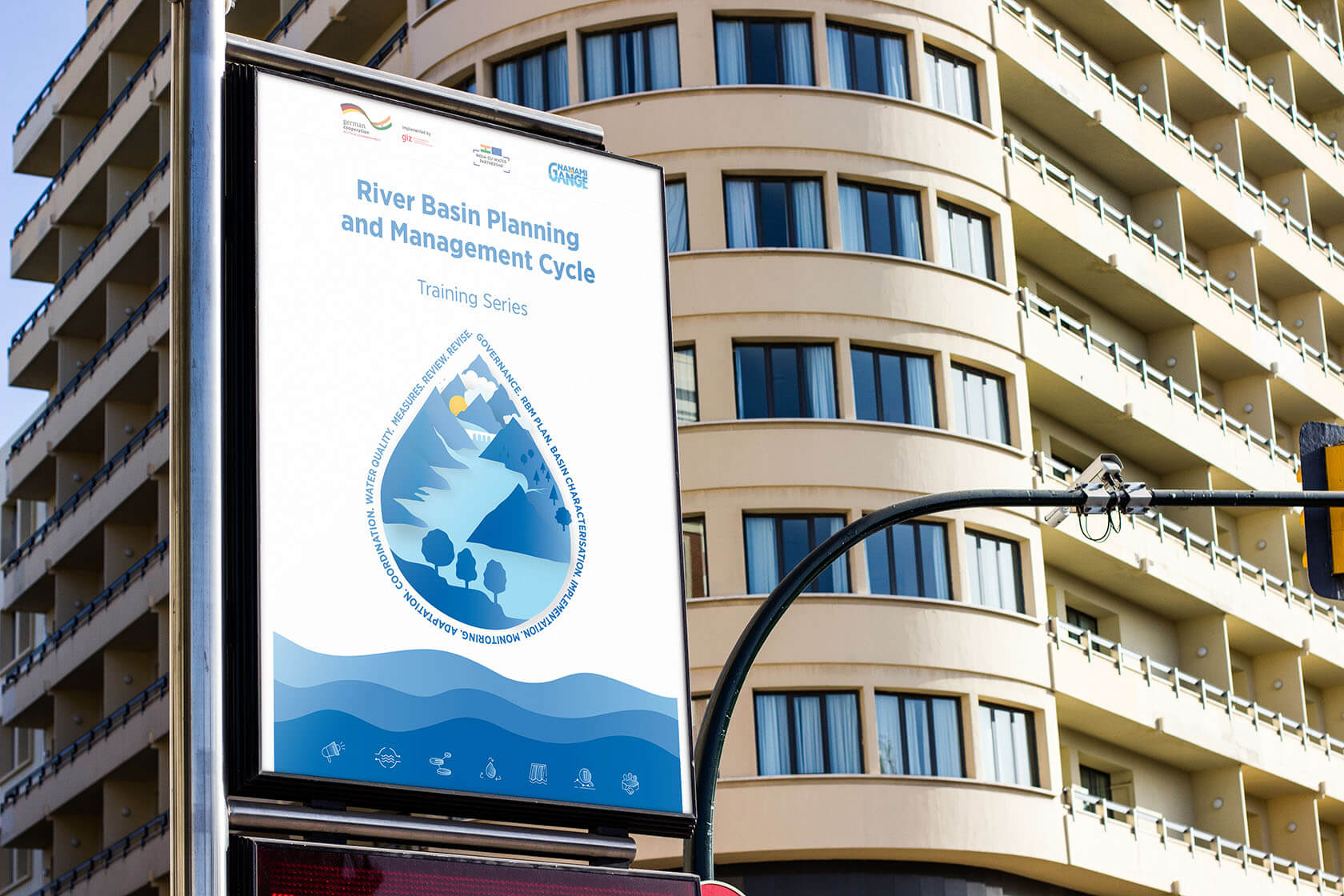
Conclusion
This particular project was an extensive one for us and since it encompassed a plethora of communication and material, we were able to tackle the brief in a multi-dimensional way. The tools developed had applications for both teachers and students, which meant that an entire segment of our education system was being targeted. Indeed, while we do not have measurable data to implicate the ‘amount’ of behaviour change this caused, we were pleased to receive a lot of positive feedback and encouragement from all the stakeholders. While behaviour change is a long, perseverent process, we firmly believe that children were at least made aware of the context. Games that they played made them seek a difference between right and wrong and initiated that spark that would enable them to be future care-givers of the environment.



